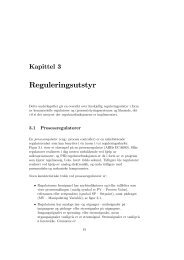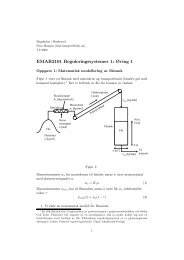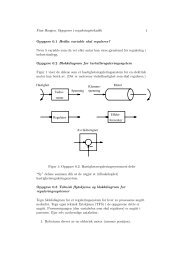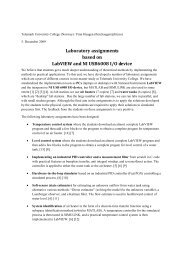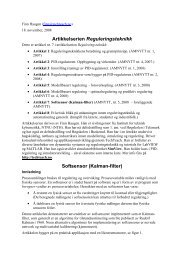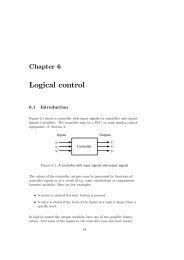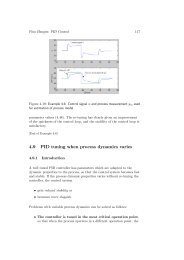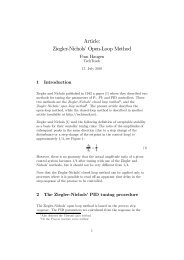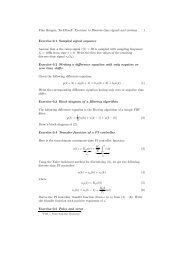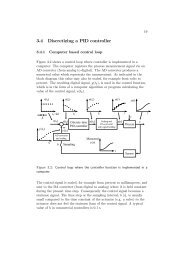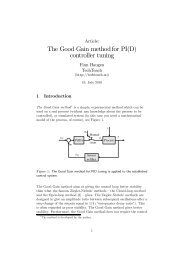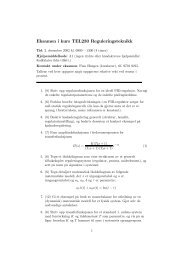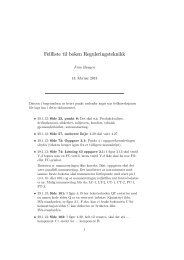Finn Haugen: Exercises to Dynamic Systems 1 ... - TechTeach
Finn Haugen: Exercises to Dynamic Systems 1 ... - TechTeach
Finn Haugen: Exercises to Dynamic Systems 1 ... - TechTeach
You also want an ePaper? Increase the reach of your titles
YUMPU automatically turns print PDFs into web optimized ePapers that Google loves.
<strong>Finn</strong> <strong>Haugen</strong>: <strong>Exercises</strong> <strong>to</strong> <strong>Dynamic</strong> <strong>Systems</strong> 1<br />
Exercise 1 Chip tank<br />
Figure 1 shows a chip tank with a feed screw and conveyor belt (the belt<br />
has constant speed). 1 There is an outflow of chip via an outlet at the<br />
Screw constant<br />
K s [(kg/min)/mA]<br />
Feed screw<br />
Mass flow<br />
w s [kg/min]<br />
Time delay<br />
τ [min]<br />
Conveyor belt<br />
w in [kg/min]<br />
Chip<br />
Screw control<br />
signal<br />
u [mA]<br />
Chip tank<br />
Chip<br />
Level<br />
h [m]<br />
Chip density<br />
ρ [kg/m 3 ]<br />
A [m 2 ]<br />
0 m<br />
w out [kg/min]<br />
To the<br />
cookery<br />
Figure 1: Exercise 1: Chip tank with a feed screw and conveyor belt<br />
bot<strong>to</strong>m of the tank. The mass flow w s from the feed screw <strong>to</strong> the belt is<br />
proportional <strong>to</strong> the screw control signal u:<br />
w s = K s u (1)<br />
The mass flow w in in<strong>to</strong> the chip tank is equal <strong>to</strong> w s but time delayed time<br />
τ:<br />
w in (t) =w s (t − τ) (2)<br />
1. Develop a mathematical model of the chip level.<br />
2. Draw an input-output block diagram of the system. Define the input<br />
and output variables, but it is assumed that the level is of particular<br />
interest.<br />
Exercise 2 Heated tank<br />
Figure2showsaheatedtankwithliquidflow. Both the liquid in the tank<br />
1 Typically, there is such a chip tank in the beginning of the production line of a paper<br />
mass fac<strong>to</strong>ry.
2 <strong>Finn</strong> <strong>Haugen</strong>: <strong>Exercises</strong> <strong>to</strong> <strong>Dynamic</strong> <strong>Systems</strong><br />
Specific heating capacity<br />
c [J/(kg K)]<br />
Mass flow<br />
w [kg/s]<br />
Heat transfer<br />
coefficient<br />
U [(J/s)/K]<br />
Environmental<br />
temperature<br />
T env [K]<br />
Inlet temperature<br />
T in [K]<br />
Density<br />
ρ [kg/m 3 ]<br />
Heating transfer<br />
coefficient<br />
U h [(J/s)/K]<br />
Heating capacity<br />
C h [J/K]<br />
Mixer<br />
V [m 3 ]<br />
T [K]<br />
Supplied<br />
power<br />
P [J/s]<br />
w<br />
T<br />
Heating element<br />
temperature<br />
T h [K]<br />
Figure 2: Exercise 2: Heated tank with liquid flow<br />
and the heating element have heat capacities. The heat transfer between<br />
the environment and the liquid is proportional <strong>to</strong> the temperature<br />
difference between them. The heat transfer between the heating element<br />
and the liquid is also proportional <strong>to</strong> the temperature difference between<br />
them. Assume homogenous conditions.<br />
1. Develop a mathematical model of the temperatures of the liquid in<br />
the tank and the heating elementet.<br />
2. Draw an input-output block diagram of the system. Consider then<br />
P , T o , T i and w as input variables and T as an output variable.<br />
Exercise 3 Ship model<br />
Figure 3 shows a ship. In this exercise we concentrate on the forward<br />
direction (i.e., the movements in the other directions are disregarded). The<br />
wind acts on the ship with the force F w . The hydrodynamic damping force<br />
F h (damping from the water) is proportional <strong>to</strong> the square of the difference<br />
between the ship speed u and the water current speed u c . Assume that the<br />
proportionality constant is D x .
<strong>Finn</strong> <strong>Haugen</strong>: <strong>Exercises</strong> <strong>to</strong> <strong>Dynamic</strong> <strong>Systems</strong> 3<br />
W ind force<br />
F w [N ]<br />
P ropeller force<br />
F p [N ]<br />
M ass m [kg]<br />
H ydrodynamic<br />
force F h [N ]<br />
P o sitio n x [m ]<br />
Ship speed (relative <strong>to</strong> earth ) u [m /s]<br />
W ater cu rren t sp eed (rel. <strong>to</strong> earth ) u c<br />
[m /s]<br />
Figure 3: Exercise 3: A ship<br />
1. What is the mathematical relation between speed u and position x<br />
2. Develop a mathematical model of the ship expressing the motion<br />
(the position) in the forward direction.<br />
3. Draw an input-output block diagram of the system. Assume that the<br />
ship position is the variable of particular interest.
4 <strong>Finn</strong> <strong>Haugen</strong>: <strong>Exercises</strong> <strong>to</strong> <strong>Dynamic</strong> <strong>Systems</strong><br />
Solution 1<br />
1. Since there is a time delay in the system (due <strong>to</strong> the transport delay<br />
of the conveyor belt) it is important <strong>to</strong> inlcude the time argument in<br />
the equations. The mass balance if the chip contents of the tank is<br />
d<br />
dt [ρAh(t)] = ρAḣ(t) = w in(t) − w out (t)<br />
= w s (t − τ) − w out (t)<br />
= K s u(t − τ) − w out (t)<br />
(3)<br />
2. Figure 4 shows the block diagram.<br />
u<br />
w out<br />
Chip tank<br />
with conveyor<br />
belt<br />
h<br />
Figure 4: Solution 1: Block diagram of chip tank with conveyor belt<br />
Solution 2<br />
1. Energy balance of the liquid in the tank:<br />
d(cρVT)<br />
dt<br />
= cρV ˙ T = cwT i − cwT + U(T o − T )+U h (T h − T ) (4)<br />
Energy balance of the heating element:<br />
d(CT h )<br />
dt<br />
= C ˙ T h = P + U h (T − T h ) (5)<br />
2. Figure 6 shows the block diagram.<br />
P<br />
T in<br />
T env<br />
w<br />
Heated<br />
tank<br />
T<br />
Figure 5: Solution 2: Block diagram of the heated tank
<strong>Finn</strong> <strong>Haugen</strong>: <strong>Exercises</strong> <strong>to</strong> <strong>Dynamic</strong> <strong>Systems</strong> 5<br />
Solution 3<br />
1. The relation between position x and speed u is<br />
ẋ = u (6)<br />
2. Force balance:<br />
m ˙u = F p + F h + F w (7)<br />
= F p + D x |u − u c | (u − u c )+F w (8)<br />
(6) and (8) constitutes the model.<br />
Alternatively, since<br />
˙u =ẍ (9)<br />
the model can be expressed as<br />
mẍ = F p + D x |ẋ − u c | (ẋ − u c )+F w (10)<br />
3. We can regard F p , F w and u c as input variables, and x as the output<br />
variable. Figure 6 shows the block diagram.<br />
F p<br />
F w<br />
u c<br />
Ship<br />
x<br />
Figure 6: Solution 3: Block diagram of the ship



